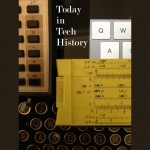 1970 – The Chang Zheng-1 rocket launched, carrying the first Chinese satellite, the Dong Fang Hong-1.
1970 – The Chang Zheng-1 rocket launched, carrying the first Chinese satellite, the Dong Fang Hong-1.
1981 – At a meeting called “Apple II Forever“, Apple introduced the portable Apple IIc. The machine came with 128 kilobytes of RAM and a 5 1/4 inch floppy disk drive.
1990 – The Space Shuttle Discovery launched with the Hubble Space Telescope on board. The following day, Hubble was released into space.
2015 – The Apple Watch started shipping. It could be bought in some high-end fashion stores but Apple Stores had none in stock. Only online orders could be taken through Apple.
Read Tom’s science fiction and other fiction books at Merritt’s Books site.